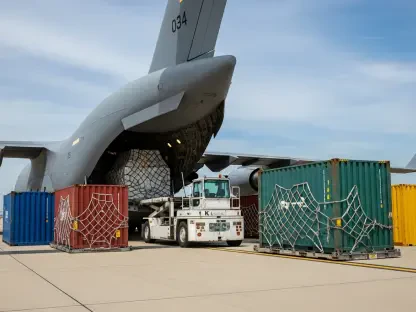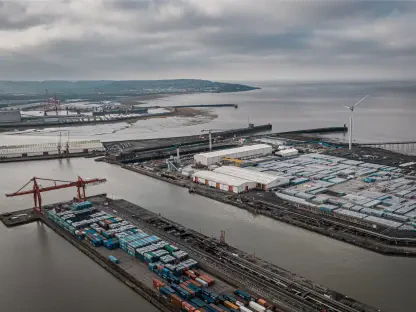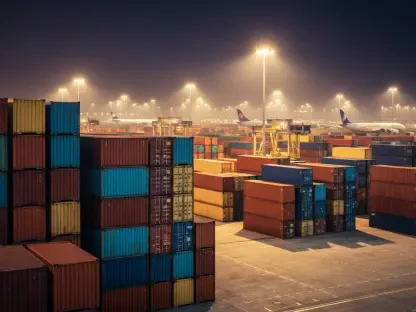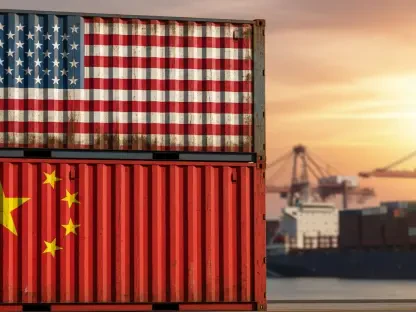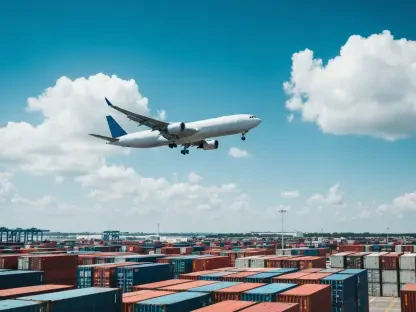The global air cargo market began 2025 with lower-than-expected growth, recording only a 2% year-on-year increase in January. This modest rise contrasts sharply with the double-digit monthly increases seen throughout the previous year. Despite these figures, industry analysts, including Xeneta, remain cautiously optimistic about the market’s prospects for the year.
Early Lunar New Year and Its Impact
Reduced Cargo Volume from China
One significant factor contributing to the reduced cargo volume in January was the earlier Lunar New Year. This holiday led to diminished volumes out of China, impacting the comparison period against January 2024, which had unusually high volumes. According to Xeneta’s Chief Airfreight Officer, Niall van de Wouw, this drop in demand was unexpected but not entirely surprising given the early holiday. He explained that the timing of the Lunar New Year resulted in a lull period that usually doesn’t occur until February, further complicating year-on-year comparisons. This temporary dip in demand affected shipping schedules and overall cargo volume, leaving the market with lower-than-anticipated growth figures for the start of the year.
High Baseline Comparison
Van de Wouw emphasizes that the slight decline in air cargo demand in January isn’t solely attributable to the earlier Lunar New Year or geopolitical tensions. Instead, it compares to an unusually high baseline in January 2024. The previous year had seen an exceptional spike in cargo volumes, making it challenging to measure current performance against such high figures. Despite this, he remains optimistic about Xeneta’s forecast for global air cargo growth of 4-6% in 2025. He believes that the fundamentals of the industry remain strong and that once the early-year distortions settle, the market should regain its expected growth trajectory. Moreover, he stresses the importance of context when interpreting these initial figures, urging stakeholders not to overreact to short-term fluctuations.
Geopolitical Tensions and Tariffs
U.S. Tariffs and Retaliatory Actions
The imposition of new tariffs by the United States, particularly targeting China, has raised concerns about a potential global trade war. These tariffs, along with retaliatory actions from China, Canada, and Mexico, have introduced a phase of uncertainty in the air cargo market. Van de Wouw believes that President Trump’s willingness to negotiate could prevent a full-blown trade war, but the uncertainty generated by these geopolitical maneuvers undermines trade confidence and stymies investment.
The implications of these tariffs extend beyond immediate cargo volumes, as long-term trade relationships and shipping routes may be altered. For example, changes in tariffs may prompt businesses to seek alternative suppliers or markets, impacting traditional air cargo routes. Additionally, the potential for sudden policy changes adds a layer of risk that can make planning and forecasting more challenging for companies involved in international trade. Businesses are now navigating a more volatile environment where short-term tactical decisions may need to be revisited frequently.
Shippers’ Response to Uncertainty
From the perspective of shippers, van de Wouw advises caution. He recommends that they remain flexible and ready to adapt to any developments rather than taking drastic measures prematurely. The atmosphere of ‘sabre-rattling’ without concrete outcomes suggests that waiting for clearer indications might be wise. Van de Wouw advises shippers to avoid making hasty decisions in response to daily news but rather to base their strategies on long-term forecasts and market fundamentals.
He also highlights the importance of agility in supply chain management, suggesting that companies build more adaptable logistics frameworks. The current geopolitical climate requires businesses to be nimble, capable of quickly adjusting routes, suppliers, and inventory levels to respond to changing conditions. According to van de Wouw, the real challenge lies in maintaining operational efficiency while dealing with these uncertainties. He suggests that companies invest in technology and data analytics to better predict and manage risks.
E-commerce Volumes and Regulatory Changes
Sustainability of E-commerce Growth
E-commerce volumes have been a significant driver behind the growth of air cargo volumes since Q3 2023. The rising cross-border e-commerce demand, particularly from China to the U.S., faces new challenges with the potential suspension of the de minimis exception. This could disrupt air freight by increasing costs and causing delays due to more stringent filing and customs processes. The de minimis rule, which allows goods below a certain value to enter the U.S. with minimal customs documentation and no duty, has been a cornerstone for efficient cross-border e-commerce. Its suspension would mean added layers of bureaucracy and potential cost increases, which could slow down the pace of e-commerce-driven air cargo growth.
Resilience of E-commerce from China
Van de Wouw comments on the resilience of e-commerce volumes from China, which grew by 20-30% last year. He suggests that consumer demand for fast and affordable goods would be robust enough to withstand the removal of de minimis benefits. However, operational delays could pose a greater threat to consumer satisfaction than price increases, potentially diminishing the attractiveness of e-commerce products due to slower delivery times.
E-commerce customers have become accustomed to rapid delivery times, and any disruptions could erode their satisfaction and loyalty. Delays caused by new regulatory hurdles at customs points may impact repeat business and customer trust, which are vital for e-commerce platforms. Van de Wouw predicts that the market may see a shift towards more localized inventory and warehousing solutions if long international shipping times become untenable. He also notes that while Chinese e-commerce platforms are expected to adapt, the adjustments required could be complex and involve substantial investments in new logistics infrastructure.
Preparedness of E-commerce Giants
Anticipation of Regulatory Changes
China’s e-commerce giants have anticipated such regulatory changes and are prepared to adapt. Van de Wouw believes these retailers will continue their efforts to meet consumer demand regardless of de minimis alterations. However, this could introduce chaos at entry points in the U.S., affecting the overall efficiency of the supply chain. These companies have already been exploring options to mitigate the impact of regulatory changes, such as diversifying their shipping routes and investing in alternative logistics networks. Despite these efforts, the sheer volume of e-commerce traffic means that any additional checkpoints or delays will be felt across the industry.
E-commerce giants have been leveraging advanced technology to streamline their supply chains, including real-time tracking systems, automated warehouses, and AI-driven logistics planning. However, regulatory changes can still create bottlenecks that technology alone cannot resolve. Van de Wouw believes that close collaboration with customs authorities and proactive compliance measures will be essential in navigating these challenges. Retailers must also prepare for potential cost increases and ensure that these do not deter consumers by maintaining competitive pricing strategies.
Impact on Freight Rates
In the long term, the demand for e-commerce could influence freight rates, but only if consumers perceive the increased wait times as unjustifiable relative to the cost savings. Current predictions on a drastic shift in freight rates would be speculative, according to van de Wouw. He notes that while higher e-commerce demand typically drives up freight rates due to increased competition for cargo space, operational delays and increased costs from regulatory changes could offset this by reducing overall shipment volumes.
Van de Wouw points out that the market will need some time to adjust to these dynamics. Freight forwarders and shippers may seek more stable, long-term contracts rather than relying on volatile spot rates. As companies navigate these evolving conditions, they may opt for more strategic partnerships with logistics providers to lock in more predictable and favorable rates. Regardless of these challenges, van de Wouw remains confident that the air cargo market will continue to adapt and find new efficiencies.
General Freight Market Dynamics
Potential Benefits for General Freight Shippers
Any slowdown in e-commerce growth could benefit general freight shippers as capacity expands in their favor, possibly decreasing rates in these sectors. However, given the stagnant growth in general air freight demand in recent years, there is little expectation of a significant improvement in these markets in 2025. General freight shippers might find themselves in an advantageous position as they could access previously unavailable cargo space, which was earlier dominated by e-commerce shipments. Lower demand for e-commerce-related air cargo could thus potentially translate into better availability and lower costs for traditional freight operators.
Despite the slow growth, general freight shippers might still face challenges such as fluctuating fuel costs and varying geopolitical conditions. The balance between supply and demand in general freight needs continuous monitoring, as any sudden uptick in e-commerce could quickly absorb the available capacity.
Modest Growth in Air Cargo Performance
The article provides a snapshot of air cargo performance in January, citing a modest 2% increase in global air cargo chargeable weight year-on-year. This is attributed to the subsiding disruptions in ocean shipping. Similarly, global air cargo capacity grew by 2%, resulting in the dynamic load factor stabilizing at 57%, comparable to the previous year. Van de Wouw notes that the air cargo industry is stabilizing following previous years of significant fluctuations. This stabilization offers a level of predictability that could benefit longer-term planning and investment in the sector.
Xeneta’s forecasts remain optimistic for a 4-6% growth in 2025, driven by improvements in operational efficiencies and the ongoing shift towards digitalization in the logistics industry. The modest increase also underlines the resilience of the air cargo sector despite facing multiple external challenges. Disruptions in ocean shipping previously caused a spike in air cargo volumes, but as maritime logistics recover, the growth rate for air freight has moderated.
Spot Rates and Trade Corridors
Elevated Global Air Cargo Spot Rates
Despite modest growth figures, global air cargo spot rates remained significantly elevated, 17% above the previous year and 56% higher than pre-pandemic levels in 2019. This surge is fueled by the e-commerce boom and limited capacity due to slow aircraft production, rerouting from Russian airspace closures, and delayed freight rate adjustments. E-commerce has driven up demand for air freight, keeping spot rates elevated even as other factors like production delays and geopolitical issues limit capacity. The ongoing issues with aircraft production and the closure of Russian airspace have created more complex routing, which further strains existing air cargo capacities.
Trade Corridor Analysis
The global air cargo sector entered 2025 with underwhelming growth, posting only a 2% year-on-year increase in January. This rather small uptick stands in stark contrast to the substantial double-digit monthly gains witnessed throughout the preceding year, signaling a notable shift in the market’s momentum. January’s figures, although modest, reflect the unpredictability of the air cargo industry, which had experienced an unprecedented surge in demand during the previous year due to various factors, including pandemic-induced changes in consumer behavior and supply chain disruptions.
Despite these less-than-encouraging numbers, industry experts, such as those at the analytical firm Xeneta, express a cautious optimism regarding the long-term prospects of the air cargo market in 2025. This tempered positivity is grounded in several factors, including ongoing global economic recovery, anticipated increases in manufacturing output, and the gradual stabilization of supply chains. These elements are expected to contribute to a more stable and potentially more robust air cargo market as the year progresses.


